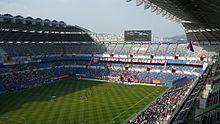Daejeon
[3][4] Located in a central lowland valley between the Sobaek Mountains and the Geum River, the city is known both as a technology and research center, and for its close relationship with the natural environment.Proponents of the Daejeon theory speculate that "Sinheung" is related to Jinhyeon-hyeon,[c] which will be discussed later and eventually connects to the place name Jinjam-dong.[d][18][19] In the Three Kingdoms Period, the area became part of Baekje's territory and was known as Usul-gun (雨述郡),centered around Eumnae-dong in Daedeok District and including Hoedeok-dong.Also on Usul-gun,in the city exists the remains of Bakjae's mountain fortress Usul-fortress (우술성)[20], which was declared a city-designated monument in 1989."[23] This legend is also recorded in early Joseon-era texts like the Geographical Appendix to the Annals of King Sejong[f][24] and the Sindonggukyeojiseungram (신증동국여지승람; 新增東國輿地勝覽), the version of Donggukyeojiseungram, updated in 1530.[25] Under Usul-gun, there were Nosaji-hyeon (奴斯只縣)[g][26] in the area of Guseong-dong, Yuseong District; Sobipo-hyeon (所比浦縣)[h] in Deokjin-dong; and Jinhyeon-hyeon (眞峴縣)[i] in Bonggok-dong, Seo-gu.Considering that the Daejeon area later generally moved in conjunction with Gongju, the dominant theory is that it belonged to the Northern parts of regional classification.Relics left by the Goguryeo army from this time can be found in Wolpyeong-dong in Seo District, Daejeon, as well as in Bugaang-myeon, Saerom-dong, and Naseong-dong in Sejong.[31] It was not until the reign of King Dongseong that Baekje, allied with Silla, succeeded in driving out the Goguryeo forces from the Daejeon area.[32] During the wars for the unification of the Three Kingdoms in 660, there is a record that the Silla army stationed at Nosurisan (怒受利山) during the Battle of Hwangsanbeol,[k] which broke out on July 9.As the Daejeon area was a border region adjacent to Hwangdeungyasangun (Nonsan), a fierce battleground, it would have been suitable for the Silla army to set up camp.The Ongsanseong (甕山城), where the revival forces blocked the Silla army's path and fought around August 661, is presumed to be Gyejoksanseong Fortress on Gyejoksan Mountain in Jang-dong, Daedeok District.According to records, Jo Bok (助服), the last military commander of Usul-gun and a second-rank Dalsol, surrendered to Silla along with a third-rank Eunsol named Paga (波伽) and their followers.[m] Later, in August 662, remnants of the revival forces gathered and fortified themselves at Naesajiseong (內斯只城),presumed to be the fortress located in the aforementioned Nosaji-hyeon (奴斯只縣) which corresponds to the now Yuseong District area ,and resisted, prompting the dispatch of 19 generals, including Kim Heumsun, to defeat them.[37] Entering the Goryeo period, Bipung-gun (比豊郡) was renamed Hoedeok-hyeon (懷德縣), Jeokjo-hyeon (赤鳥縣) became Deokjin-hyeon (德津縣), and Jinryeong-hyeon (鎭嶺縣) was changed to Jinjam-hyeon (鎭岑縣), while Yuseong-hyeon remained unchanged.[39] Subsequently, during King Myeongjong's reign, Hoedeok-hyeon and Jinjam-hyeon were promoted to "ju-hyeon" (main counties), and officials known as "Gamwu" (監務)[q] were dispatched, initiating independent administration.The area that is now the central part of Daejeon remained a small rural village within Gongju, which had been re-elevated to Gongju-mok during the reign of King Chung-hye of Goryeo.Meanwhile, the name "Daejeon" (大田), which is the Hanja transcription of the native term "Hanbat" (한밭) for Great Fields, first appeared in records in the early Joseon period,in Donggukyeojiseungram, and continues to be used today.With Yuseong joining Daejeon-gun, the region roughly restored the combined territory of the central area and its subordinate prefectures from the times of Usul-gun and Bipung-gun.In 1983, Daejeon further expanded by incorporating the entire areas of Yuseong-eup and Hoedeok-myeon of Daedeok-gun, and parts of Tan-dong, Gujeok, Jinjam, and Giseong-myeon.In the late 1980s, Daejeon was elevated to the status of Special City (Jikhalsi), thus became a separate administrative region from South Chungcheong Province.[45] Daejeon is divided into five political "gu" or "districts": Seogu (서구), Donggu (동구), Yuseonggu (유성구), Daedeokgu (대덕구), and Junggu (중구).Sungheon Seowon was rebuilt in 1609 (the first year of King Gwanghaegun) by Song Nam-su (宋柟壽) after being destroyed during the Imjin War, and its ruins remain in Wonchon-dong.Among the technology produced in Daedeok are ETRI's wireless communications systems CDMA, WIBRO, and DMB, KRIBB's nano biochips, KARI's KOMPSAT satellites, and NFRI's KSTAR nuclear fusion experimental reactor.[62] Daedeok is also home to 21 corporate research centers with global reach surrounded by an equal number of smaller firms.[74][75] Daejeon citizens are recognized for their fondness of nature, with most mountains, hot springs, and rivers freely open for public use.The park contains water springs, trails, Buddhist temples, and some heritage sites dating back as far as the Bronze Age.The city is also home to LPGA golfers Pak Se-ri and Jang Jeong, and is the hometown of former New York Mets left-handed reliever Dae-sung Koo.Between 1986 and 2024, they played their home games at the Daejeon Hanbat Baseball Stadium, built in Busa-dong in 1964, with an iconic view of Bomunsan in the outfield.








Metropolitan CityHangulRevised RomanizationMcCune–ReischauerDaejeoncheonDaejeon Railway StationRegionMayor–councilPeople PowerDaejeon Metropolitan CouncilChungcheongISO 3166 codeWhite magnoliaKorean magpieKoreanfifth-largest metropolisSobaek MountainsGeum RiverGwacheonSejong CityKorea Advanced Institute of Science and TechnologyChungnam National UniversitychaebolsSamsungDaedeok Yeongu Danji.Daejeon Government Complex1986 Asian GamesExpo 1993International Mathematical Olympiads2027 Summer World University GamesmonsoonDonggukyeojiseungramYuseong districtDong-guGongjuDaedeok DistrictBronze AgeProto–Three Kingdoms PeriodSeosanYesan CountySouth Chungcheong ProvinceThree Kingdoms PeriodBaekjeGeographical Appendix to the Annals of King SejongBattle of HwangsanbeolNonsanUnified SillaGoryeoJoseonSpecial CityMetropolitan CitiesKorea Forest ServiceCultural Heritage AdministrationKorean Intellectual Property OfficeKorailKorea Water Resources CorporationKorea Minting and Security Printing CorporationSejong Special Self-Governing CityGwangjuGyeryongsan National ParkSobaek MountainYellow SeaGunsanhumid subtropicalhumid continentalKöppenprecipitationrelative humiditysunshine hourspossible sunshineultraviolet indexKorea Meteorological AdministrationDongguYuseongguDaedeokguJungguDong DistrictJung DistrictSeo DistrictBuddhismProtestantismCatholicismnational universityDaejeon Chungnam UniversityHanbat National UniversityAsiaweekbusiness educationMokwon UniversityKorean MethodistPai Chai UniversityWoosong UniversityHannam UniversityDaejeon Science High SchoolTaejon Christian International SchoolBomoon High SchoolDaedeok Innopolisnanofabricationbiotechnologynuclearhydro powernuclear fusionfuel cellsKorea Research Institute of Bioscience and BiotechnologyKorea Atomic Energy Research InstituteKorea Aerospace Research InstituteKorea Astronomy and Space Science InstituteKorea Basic Science InstituteInstitute for Basic ScienceKorea Research Institute of Chemical TechnologyKorea Institute of Science and Technology InformationKorea Research Institute of Standards and ScienceInstitute of Information Technology AdvancementAgency for Defense DevelopmentKorea Institute of Nuclear SafetyRare Isotope Science ProjectNational Research Foundation of KoreaKOMPSATHankook TireDaejeon Museum of ArtLee Ungno MuseumExpo Science ParkTaejŏn Expo '93National Science MuseumKorea Institute of Geoscience and Mineral ResourcesDaejeon Artist HouseSikjangsan


